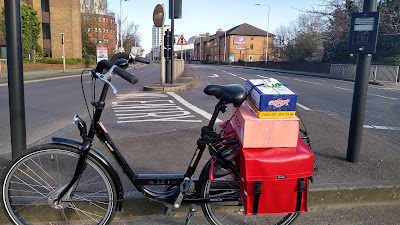Technology is a funny thing. Ideas come and go, yet every so often, we come up with an idea which is so perfect, it is hard to see why it doesn't automatically become our solution of choice.
I present to you the bicycle. This technological marvel is the most efficient way to move the average human, maybe four times as efficient than walking in energy terms and certainly so space efficient that the standard method of traffic modelling had the bicycle at 0.2 passenger car units. When I talk about "the bicycle" I actually just mean "cycles" given how many different configurations there are - people come in a wide variety and so why not their locomotion?
My bicycle.
Transport perfection for local trips which are too far for me to walk.
Cycles have been with us for a couple of hundred years and so it isn't a surprise that some people consider them a relic of the past; a transport option that has no place in the 21st Century. Consider this though, they have been with us longer than the motor car (by about 70 years) and the first underground railway (by about 50 years).
Cycles may have been the preserve of the rich enthusiast to start with, but they soon became the cheap transport option for the masses. The technology is credited with giving women social mobility and in places with high cycle use, the technology has helped with social inclusion and cohesion. Of course, the experience and the needs of the individual will vary, but at a population level, cycling really is an amazing thing.
At least in a UK context, driving is held up as the transport option of the person and of freedom - something the manufacturers play on with their promise of streets free from other people driving or empty roads through the desert, things which are rare in the experience of most who drive. For some owning a car is seen as aspirational; a signal to others that someone has done well in life (something which politicians on both the right and left like to grab onto).
London's Embankment before Cycleway 3 was built.
Full of freedom and important working people efficiently going about their lives or something.
Cycling on the other hand is seen as transport for the poor, a mode either used by people on the edges of society or by virtue-signalling, sandal-wearing eco-hippies. At the same time it is also seen as a hobby for rich entitled middle class lycra louts who simultaneous hold drivers up and cycle too fast. It's an odd thing to see people getting so upset when we try and build something to keep people cycling safe from traffic. It's even odder to see the cogs turning when you tell them it's not cycling infrastructure, it's motoring infrastructure.
Anyway, this mini-celebration of the bicycle (cycle) is brought to you from my day out with the family this week which included a visit to the Natural History Museum in London. On leaving it, my eldest suggested he and I cycle back to Liverpool Street as there is a hire bike dock right by the museum. A brace of hire bikes was duly procured and we set off along the horror show that is Exhibition Road for the safety of the C3 Cycleway that he and I have used together for nearly a decade of exploration around our city.
We took a gentle 40 minutes to cycle the route, mainly side by side which is the thing that being protected from motors enables. It was just a simple and easy choice for our trip, compared with the Tube or the buses at the afternoon peak. Getting round like this really needs to be open to as many people as possible if we are going to make our urban places liveable




No comments:
Post a Comment